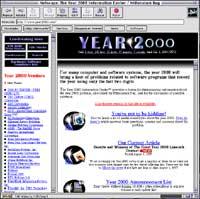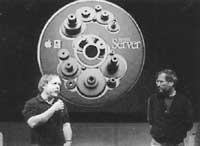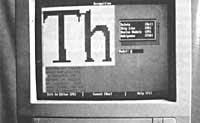Towards the Computer Apocalypse of 2000
1997/10/01 Elizondo, Luis Iturria: Elhuyar aldizkaria
Within two years, software programs that use only the last 2 digits to indicate the year will generate serious problems anywhere.
All the world watches take us towards the year 2000 without remedy, second to second, without rest. When someone does not invent the time machine, at least, you cannot retreat. So, what will happen in world computer systems after 2000? Chaos? Disaster? What is that question that concerns all the computer managers of the world?

We will understand it with a small example. Imagine that after hearing the chimes of New Year's Eve 1999, after swallowing the essential grapes running and in haste, you want to congratulate the friend or family member or lover who has gone to the Canary Islands. Take the phone at 0:10 at night and taking advantage of the lack of monopoly of Telefónica (from now on, fortunately or unfortunately, we will have duopoly), make a long conference of 20 minutes at that time, in the last century, with the interlocutor of the islands that, in the opinion of some, are in the previous millennium.
Once the phone is hung, if the phone company has not corrected its software, you will be about to lose all the money saved in your life, because you will receive the invoice of the call that has lasted between January 1, 00 and December 31, 99, that is, an interprovincial call of 99 years!
Similar problems and errors will arise from that date in any field, as as the Western world passes from 1999 to 2000, many computer programs will be delayed from 99 to 00. Why? The reason is very simple. In the 1960s and 1970s, by saving the precious memory of overly expensive computers, programmers decided to write dates with 6 digits to indicate day, month and year.
For example, “October 6, 1973” became “731006”. That is, they left out the “19” that was repeated at all times because it was useless; the year 2000 was far away to worry or to be distressed. And what does it mean right now? To understand the problem, we must analyze the most basic and simple calculations that computers perform repeatedly. That is, computer calculations to know how long has passed from one event to another. For example, how old am I?
I was born on May 21, 1965. If a computer is asked how old I am, it will deduct taking into account the current date: 97-65=32. But in 2000 I would also do the same operation, that is, between 00-65, and then I would decide that I am -65 years old. No doubt, such calculations will cause errors and misunderstandings. And not only because of the age of people, but all the information that is based on time also crumbles.

Everything. When will the credit card deadlines end? How long can you take this medicine? When will the subscription to this magazine end? What will happen to the 1999 New Year's Eve night flights? What will banks pay for interest? And what is charged for loans? All these questions are based on time and if the computer does not know what the actual date is today, it will not be able to answer correctly.
And if the reason for the barbarism that comes to us is so simple, why didn't they foresee all this 20 years ago? I knew that someday the year 2000 would come, right? Yes, but when computers began to enter the business world in the 1960s and 1970s, they were more expensive than expensive. And the simplest way to lower those high prices was to restrict the data that computers should store. And also, the less data they used, the more speed they could get, so they advanced with the digit restriction. At that time the data was stored in slotted cards with capacity for 80 characters per card.
And the truth is that 80 characters are very few to write anything. When writing a date, therefore, instead of putting “23 August 1953” (18 characters), or “23/08/1953” (10 characters), they decided to write “530823” (6 characters), forgetting that “19” ditxoso. Writing dates only with 6 digits was much more logical, more logical and economical.
When choosing this compromise solution, programmers knew that the year 2000 would come, of course, but there were 30 or 40 long years left for it and they believed that the programs would then have no value in the future. And in that conviction they were wrong, they failed. Even if it seems a lie, many codes of those times are used today, as many software programs have passed from one application to another, as if it were a biological heritage.
Very good. If the problem is just that, why not add the magic number “19” on the dates of all computer programs? It seems simple. Grab the incorrect date code, deliver it to a programmer and he will add the missing two digits. Unfortunately, the question is very different.

Carrying it forward is not easy, because no one knows where the dates are. Each programmer hid these digits differently. While one used the word date, another would opt for the day, and perhaps someone used Pamela Anderson. Who knows! Programming and creating are often interrelated and the creator has all the freedom to perform his work. Consequently, all software programs should be explored to add the famous “19” to the two-digit years.
Of course! But in the last 30 years millions and millions of program lines have been written, thousands of computer applications have been built and it is very normal for a current company today to have 100 million lines in its computer programs. Therefore, you should read all these lines to find and change dates.
If you give a single second per line and only work 8 hours a day, a person would take 13 years to solve the problem of the company, approximately. Or 13 people in a year. And who should spend that amount? Most companies do not. Currently only 40% of US companies have faced the problem and in Europe we are even worse. And as in other projects, the year 2000 will not be delayed, it is not possible. There are less than 120 weeks left.
And that's the question. We know what needs to be done, but now, at the gates of the new century, the solution is very difficult, very expensive, and many experts consider that there is no time to review and rewrite all programs. It is too late, unfortunately.
While you read this article, the year 2000 has come a little closer, at least a few minutes have passed. Less and less time remains. However, if you want to receive more information on the subject before falling into the computer chaos, you can go to the addresses of the Internet table.

Gai honi buruzko eduki gehiago
Elhuyarrek garatutako teknologia





